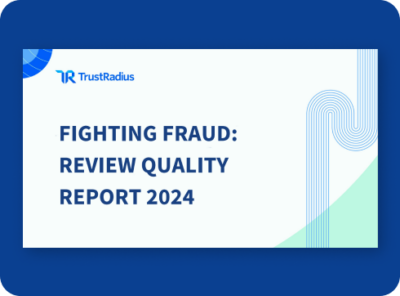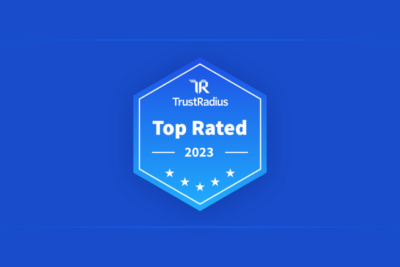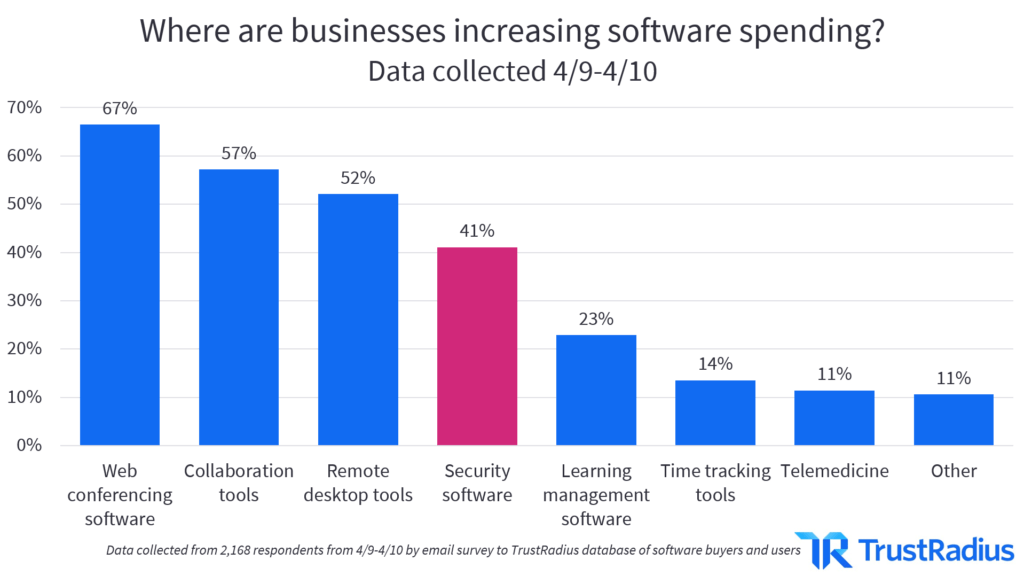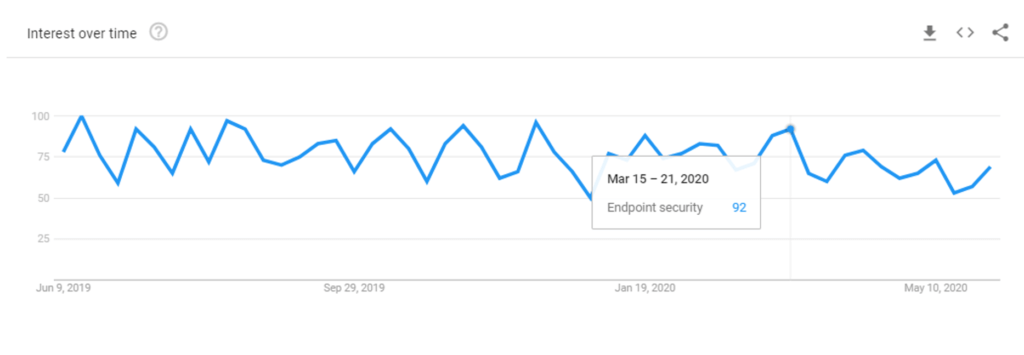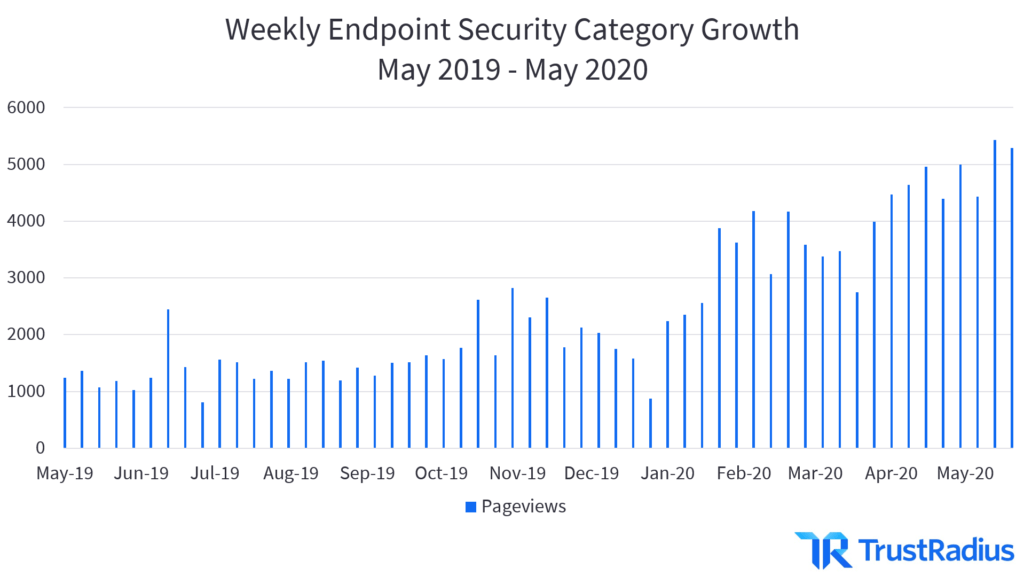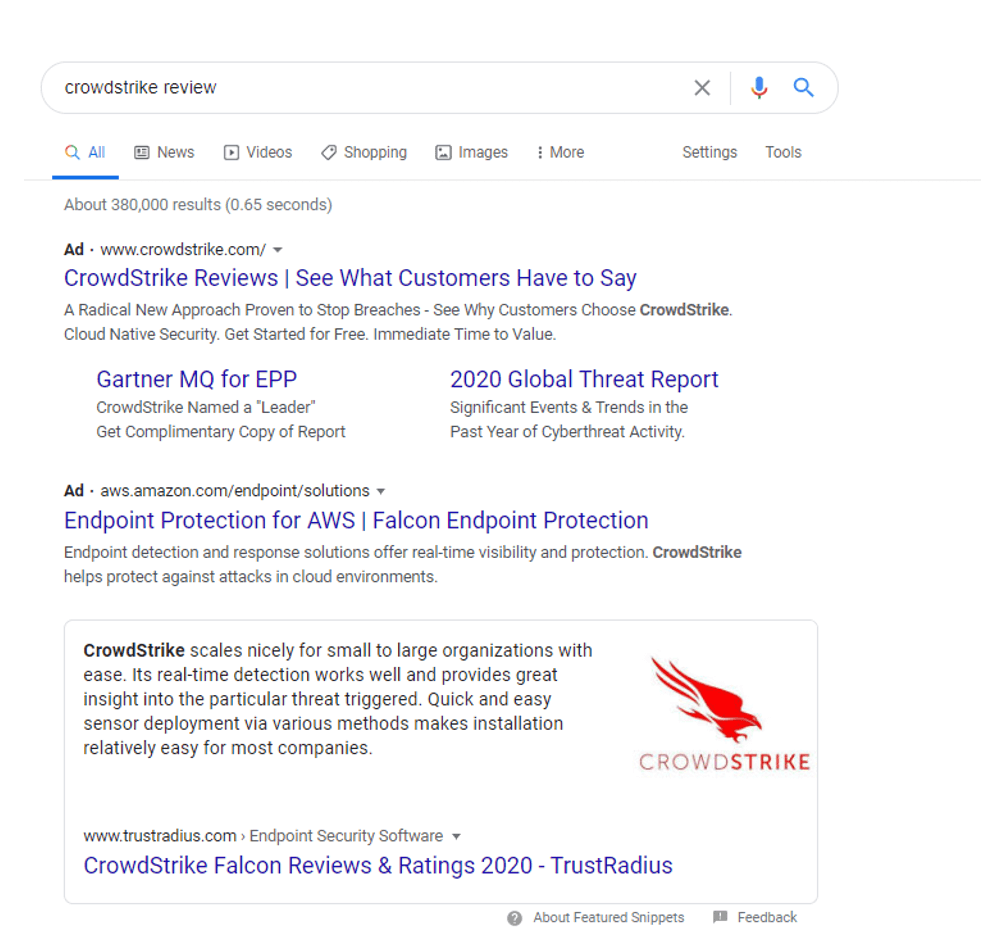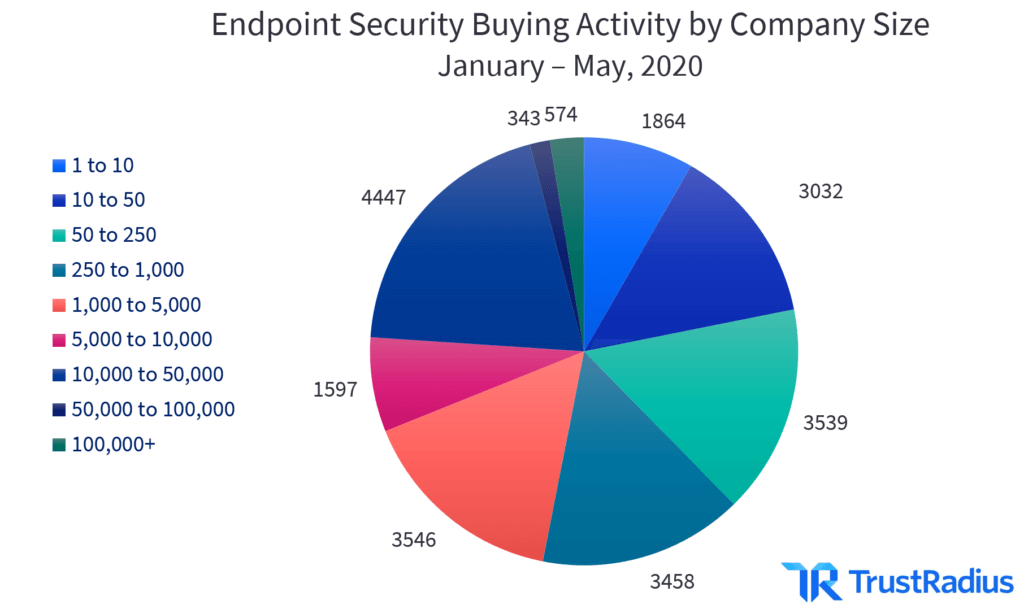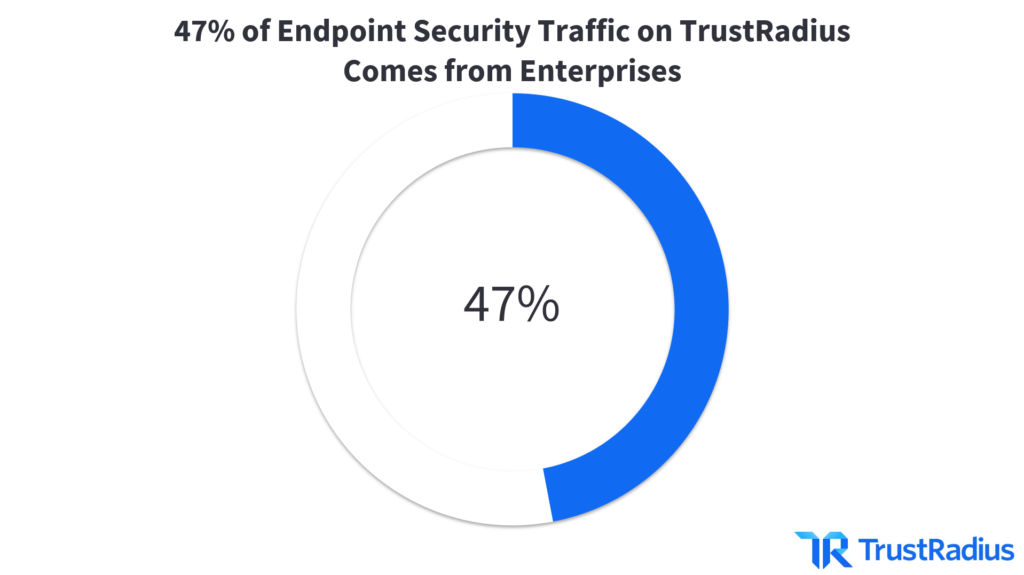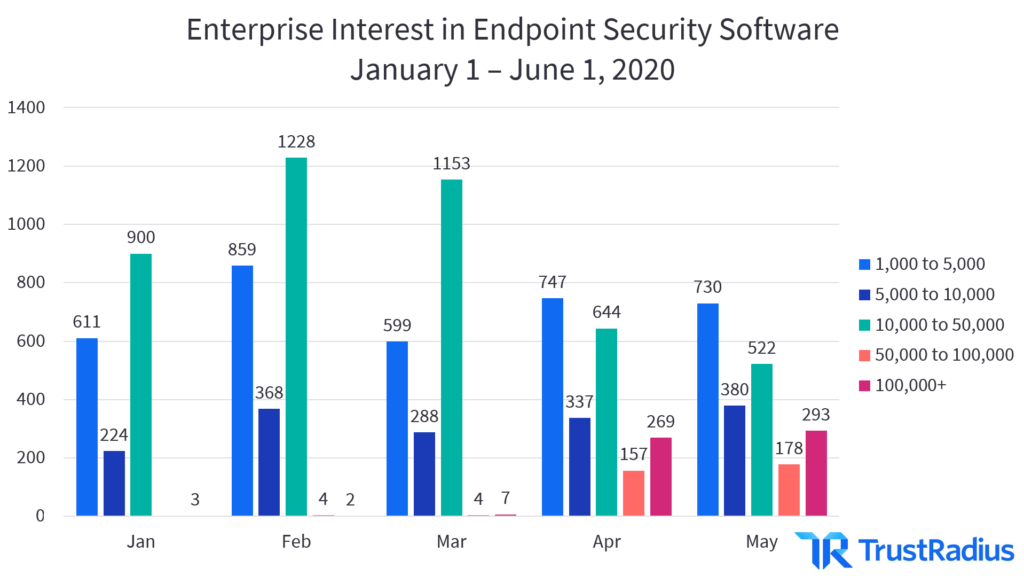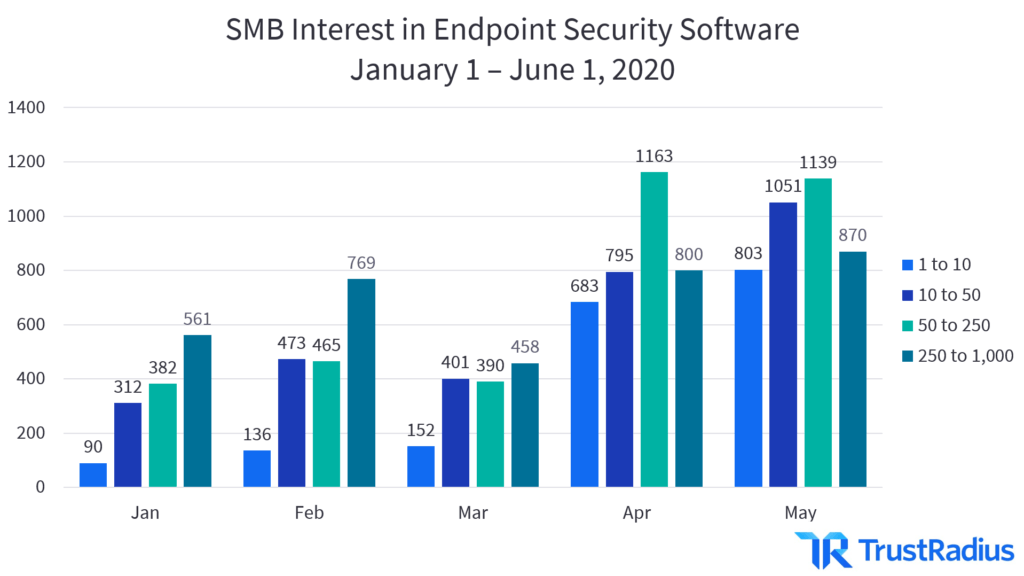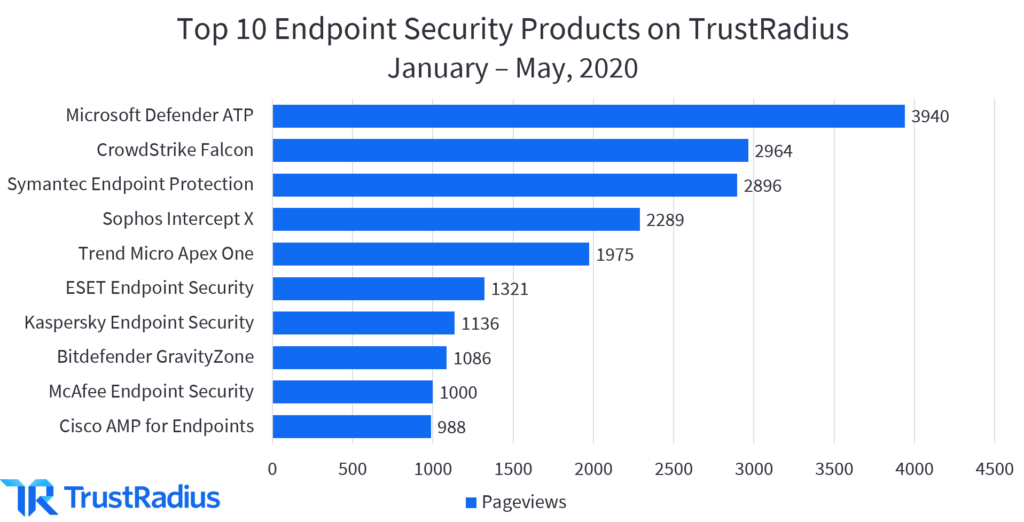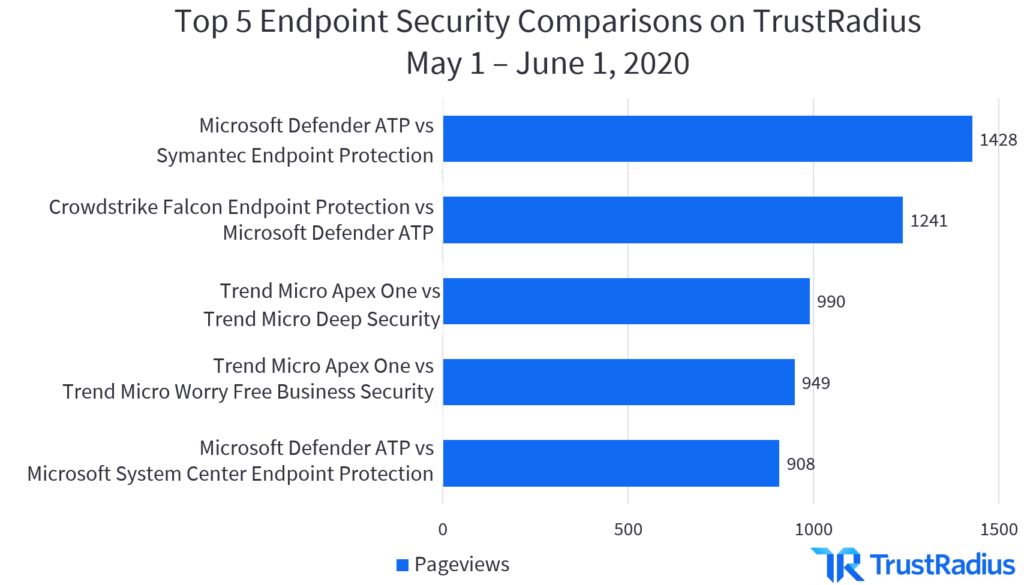
Endpoint Security Statistics and Trends
The COVID-19 pandemic has shifted from a disruption to a long-term reality until a vaccine can be developed and distributed. As businesses shift from transition planning to multi-year strategizing, robust security with protection for remote-first workforces is a necessity. Many companies were planning to purchase new security software as early as March, according to a survey of software buyers we conducted when the remote transition began.
The rest of this article discusses the historical and real-time trends for endpoint security software. It explores how COVID-19 has impacted buyer interest and purchase intent patterns, including the most popular tools and comparisons.
Quick Access
Historical Interest in Endpoint Security Software
Security software such as endpoint security technology and Virtual Private Networks were gaining steam even before the pandemic. Given the long-term shift towards remote work that was in progress before COVID-19, endpoint security has been a key consideration for security professionals for over a year now. Market interest in endpoint security has remained consistent through the last year according to data from Google Trends. As shown in the graph below, there was an uptick of interest at the start of the work-from-home transition that has since declined slightly over the last month or two.
As companies plan their long-term remote workforce strategies, which may become permanent, there are unique security challenges that must be addressed. Some cybersecurity providers reported as much as a 4,500% increase in attempted endpoint attacks since early March. The rapid and dramatic escalation in attempted attacks creates a sustained demand for endpoint security software.
The Growth of Endpoint Security Before and During COVID-19
While Google Trends shows that overall interest in endpoint security software has remained fairly stable over the past year, this category has been rapidly growing on TrustRadius for the last 6 months. That growth escalated as businesses quickly transitioned to remote workforces. Demand for endpoint security software continues to grow as organizations plan for long-term remote work.
Looking at website traffic for the endpoint security category on TrustRadius over the past year, weekly traffic has grown dramatically since late 2019. This trend intensified during COVID-19. However, endpoint security traffic was rising even before the pandemic impacted the business world. As of June 2020, the upward trend suggests that we have not hit the “peak” interest in the category. Traffic is projected to increase over the coming weeks and months.
Traffic to the endpoint security category on TrustRadius increased by nearly 4X year over year. Much of that growth has emerged since early February. Some of the traffic increase can be attributed to COVID-fueled interest, as discussed above.
The growth that was emerging even before COVID-19 can be attributed to TrustRadius’s investment in SEO and improvements in category coverage. Our in-depth content is easily accessible to Google, adding visibility to the category’s detailed user reviews, dynamic comparisons based on reviews, product descriptions, feature lists and ratings, and pricing information.
This positions our site to rank highly in search results. For example, Google’s Featured Snippets pull content from TrustRadius directly into the SERP (shown below). Google does this when it considers our site to provide helpful content most likely to provide users with the “answers” to their search queries. Featured snippets drastically increase organic traffic to the products and comparisons on our site by placing our content at “position zero,” which is the first result to be shown after paid ads.
Who’s in the Market for Endpoint Security Software?
As software spending begins to stabilize, vendors in the endpoint security space need insights into which segments are still ramping up their investment in endpoint security and have the most potential for growth in the near future.
Based on True Intent signals, we identified several trends in the companies that are most actively researching endpoint security software. The pie chart below shows the number of visitors from each company size segment since the beginning of this year (January 1st to June 1).
True Intent data from the last 5 months shows that enterprise organizations with at least 1,000 employees constitute nearly half (47%) of traffic to the endpoint security category on TrustRadius.
Endpoint security software is a valuable component of any business’s security strategy, particularly when securing remote endpoints. Enterprise networks magnify the importance of this protection. Enterprise networks are larger in scale, with more endpoints that need protection. They also have a wider range of endpoint types, including IoT devices and servers with unique protection requirements.
The strong presence of enterprise-scale buyers is impactful for vendors in the endpoint security market. Endpoint security software is most commonly priced per user or per endpoint. This pricing structure means that endpoint security vendors should focus their COVID-era pipeline on enterprise clients, especially very large enterprise clients.
The potential for high-end enterprise deals appears to have grown in the last two months. Smaller enterprises, while still active in the market, peaked in research activities in late February and March. In contrast, large enterprises with 50,000 or more employees have drastically ramped up their endpoint security research on TrustRadius since the start of April. Based on activity throughout May, large-scale enterprise interest in endpoint security software is still growing.
Buyer activity in the SMB market has also consistently grown since April. As shown in the graph below, there were 187% more SMB visitors to the endpoint security category in May compared to January. Like the largest enterprises, small to midsized businesses appear to still be increasing their investments in endpoint security software. The upward trend in SMB visitors suggests that there are still new endpoint security buyers entering the research and evaluation process across market segments.
The key takeaway for vendors in the endpoint security market is that there are opportunities to sell to a range of company sizes. In particular, there are more opportunities to engage with very large enterprises that did not exist prior to the COVID-19 pandemic.
Top Tools in Today’s Endpoint Security Market
Today’s endpoint security market includes both legacy cybersecurity giants and more specialized point solution vendors. The category leader on TrustRadius is Microsoft Defender ATP, which accounts for 16.6% of endpoint security traffic. Crowdstrike (12.1% of traffic) and Symantec (10.6% of traffic) also stand out as leaders.
| Product | Pageviews |
| Microsoft Defender ATP | 3,940 |
| CrowdStrike Falcon | 2,964 |
| Symantec Endpoint Protection | 2,896 |
| Sophos Intercept X | 2,289 |
| Trend Micro Apex One | 1,975 |
| ESET Endpoint Security | 1,321 |
| Kaspersky Endpoint Security | 1,136 |
| Bitdefender GravityZone | 1,086 |
| McAfee Endpoint Security | 1,000 |
| Cisco AMP for Endpoints | 988 |
Microsoft Defender ATP is also among the most frequently compared endpoint security products. Three out of the top five most common product comparisons include Defender ATP. These comparisons are content that visitors spend incredibly long periods of time on. The average time spent on these five comparisons is nearly 15 minutes.
Interestingly, three out of the top five comparisons are between products from the same vendor: Microsoft. We see a similar trend with Trend Micro products later on in the list. This suggests that buyers have a difficult time differentiating between endpoint security products from the same vendor and determining which one is best for their use case.
For instance, Microsoft System Center Endpoint Protection is considered more of a “default” protection system, with more basic capabilities and lower costs, while Defender ATP has a much more robust feature set and heftier price tag. In contrast, Trend Micro’s offerings differentiate on a point solution vs. all-in-one spectrum. Apex One is focused on endpoint security specifically, while Deep Security is a unified security package designed to protect hybrid cloud environments.
Many of the endpoint security leaders highlighted above have taken steps to make their offerings more accessible to new and current customers during the COVID-19 pandemic. For instance, Microsoft has added new views of endpoint threats that are targeting remote workers and offered recommended configurations for businesses implementing Defender ATP in a remote environment. Other vendors, such as Crowdstrike, have benefited from their cloud-first models. Cloud-based applications have become a necessity in a matter of weeks or months, resulting in recent stock gains.
Endpoint Security Market Growth on TrustRadius vs. G2 and IT Central Station
Over the last few months, software buyers in the endpoint security market have increasingly chosen TrustRadius as the most trusted site for researching endpoint security products. Site visitors to the Endpoint Security category on TrustRadius started increasing as early as December, with higher growth starting in April.
In contrast, endpoint security traffic on other B2B software review websites, like G2 and IT Central Station, has remained stagnant. Traffic to our category page alone, which serves as a starting point for buyers researching endpoint security options, has increased 4X since December. Other sites have not seen such growth over this time.
Our comparative growth can be attributed in part to SEO improvements we have made to the category and across the website, and in part to the higher quality content users find on TrustRadius. For example, we’ve seen higher engagement from endpoint security buyers over the past year. The average time spent on each page for the endpoint security category increased 23% year over year, from 5 minutes in June 2019 to nearly 7 minutes in May 2020. Buyers tend to spend especially long times on TrustRadius comparison pages– averaging around 15 minutes. These comparison pages are particularly influential to buyers in the evaluation and selection stages.
Endpoint security buyers are highly engaged on the TrustRadius platform because of our high-quality, in-depth content. Across the 335 reviews of endpoint security software on TrustRadius, the average review contains 310 words. In comparison, G2 reviews average just 130 words. Detailed answers to key questions, like use case, top pros and cons, and ROI, make TrustRadius the most valuable resource for buyers seeking endpoint security software reviews.



